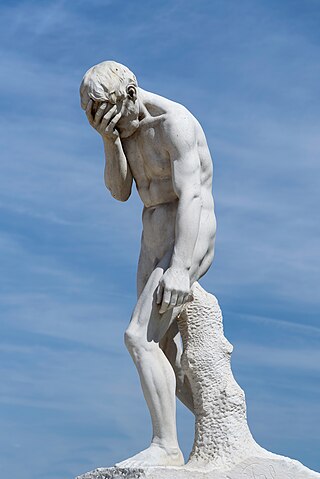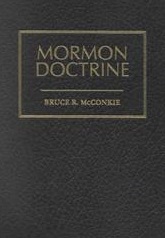
Brigham Young was an American religious leader and politician. He was the second president of the Church of Jesus Christ of Latter-day Saints, from 1847 until his death in 1877. During his time as church president, Young led his followers, the Mormon pioneers, west from Nauvoo, Illinois, to the Salt Lake Valley. He founded Salt Lake City and served as the first governor of the Utah Territory. Young also worked to establish the learning institutions that would later become the University of Utah and Brigham Young University. A polygamist, Young had at least 56 wives and 57 children. He formalized the prohibition of black men attaining priesthood, and led the church in the Utah War against the United States.
Early Mormonism had a range of doctrines related to race with regards to Black people of African descent. References to Black people, their social condition during the 19th and 20th centuries, and their spiritual place in Western Christianity as well as in Mormon scripture were complicated.
During the history of the Latter Day Saint movement, the relationship between Black people and Mormonism has included enslavement, exclusion and inclusion, official and unofficial discrimination, and friendly ties. Black people have been involved with the Latter Day Saint movement since its inception in the 1830s. Their experiences have varied widely, depending on the denomination within Mormonism and the time of their involvement. From the mid-1800s to 1978, Mormonism's largest denomination – the Church of Jesus Christ of Latter-day Saints – barred Black women and men from participating in the ordinances of its temples necessary for the highest level of salvation, prevented most men of Black African descent from being ordained into the church's lay, all-male priesthood, supported racial segregation in its communities and schools, taught that righteous Black people would be made white after death, and opposed interracial marriage. The temple and priesthood racial restrictions were lifted by church leaders in 1978. In 2013, the church disavowed its previous teachings on race for the first time.

In Latter-day Saint theology, Egyptus is the name of two women in the Book of Abraham in the Pearl of Great Price. One is the wife of Ham, son of Noah, who bears his children. The other is their daughter, who discovered Egypt while "it was under water" (1:23-24). Three 1835 pre-publication manuscripts of the Book of Abraham, in place of "Egyptus", read Zeptah for the elder Egyptus and Egyptes for the younger Egyptus.

In the Latter Day Saint scripture the Book of Abraham, Pharaoh is the proper name of the first king of Egypt. According to the story, all Egyptians descended from him. He was the eldest son of Egyptus, who was the daughter of Ham and Egyptus. Pharaoh was a descendant of the Canaanites, a race of people who according to Latter Day Saint theology had been cursed with black skin. Leaders of the Church of Jesus Christ of Latter-day Saints have taught that he inherited the curse of Cain through his grandmother, Egyptus, so that the devil might have representation upon the earth.

The curse of Cain and the mark of Cain are phrases that originated in the story of Cain and Abel in the Book of Genesis. In the stories, if someone harmed Cain, the damage would come back sevenfold. Some interpretations view this as a physical mark, whereas other interpretations see the "mark" as a sign, and not as a physical mark on Cain himself. The King James Version of the Bible reads "set a mark upon Cain".

In the Book of Genesis, the curse of Ham is described as a curse which was imposed upon Ham's son Canaan by the patriarch Noah. It occurs in the context of Noah's drunkenness and it is provoked by a shameful act that was perpetrated by Noah's son Ham, who "saw the nakedness of his father". The exact nature of Ham's transgression and the reason Noah cursed Canaan when Ham had sinned have been debated for over 2,000 years.
The Church of Jesus Christ of Latter-day Saints teaches that Adam and Eve were the first man and the first woman to live on the earth and that their fall was an essential step in the plan of salvation. Adam in particular is a central figure in Mormon cosmology.

Mormon Doctrine is an encyclopedic work written in 1958 by Bruce R. McConkie, a general authority of the Church of Jesus Christ of Latter-day Saints. It was intended primarily for a Latter-day Saint audience and has been used as a reference book by church members because of its comprehensive nature, and was a highly influential all-time bestseller in the LDS community. It was viewed by many members both then and now as representing official doctrine despite never being endorsed by the church. It has been both heavily criticized by some church leaders and members and well regarded by others. After the book's first edition was removed from publication at the instruction of the church's First Presidency and Quorum of the Twelve, corrections were made in subsequent editions. The book went through three editions but has been out of print since 2010.
From 1852 to 1978, temple and priesthood policies in the Church of Jesus Christ of Latter-day Saints prohibited women and men of Black African descent from temple ordinances and ordination in the all-male priesthood. In 1978, the church's highest governing body, the First Presidency, declared in the statement "Official Declaration 2" that the restriction had been lifted. Between 1830 and 1852, a few Black men had been ordained to the Mormon priesthood in the Latter Day Saint movement under Joseph Smith.

The Latter Day Saint movement has had varying and conflicting teachings on slavery. Early converts were initially from the Northern United States and opposed slavery, believing that their opposition was supported by Mormon scripture. After the church base moved to the slave state of Missouri and gained Southern converts, church leaders began to enslave people. New scriptures instructing Latter-Day Saints not to intervene in the lives of the enslaved people were revealed. A few enslavers joined the church, and when they moved to Nauvoo, Illinois, they illegally took their enslaved people with them, even though Illinois was a free state.
Exaltation is a belief in Mormonism that after death some people will reach the highest level of salvation in the celestial kingdom and eternally live in God's presence, continue as families, become gods, create worlds, and make spirit children over whom they will govern. In the largest Mormon denomination, the Church of Jesus Christ of Latter-day Saints, top leaders have taught God wants exaltation for all humankind and that humans are "gods in embryo". A verse in the LDS Church's canonized scripture states that those who are exalted will become gods, and a 1925 statement from the church's highest governing body said that "All men and women are in the similitude of the universal Father and Mother ... [and are] capable, by experience through ages and aeons, of evolving into a God."
In the past, leaders of the Church of Jesus Christ of Latter-day Saints have consistently opposed marriages between members of different ethnicities, though interracial marriage is no longer considered a sin. In 1977, apostle Boyd K. Packer publicly stated that "[w]e've always counseled in the Church for our Mexican members to marry Mexicans, our Japanese members to marry Japanese, our Caucasians to marry Caucasians, our Polynesian members to marry Polynesians. ... The counsel has been wise." Nearly every decade for over a century—beginning with the church's formation in the 1830s until the 1970s—has seen some denunciations of interracial marriages (miscegenation), with most statements focusing on Black–White marriages. Church president Brigham Young taught on multiple occasions that Black–White marriage merited death for the couple and their children.
Civil rights and Mormonism have been intertwined since the religion's start, with founder Joseph Smith writing on slavery in 1836. Initial Mormon converts were from the north of the United States and opposed slavery. This caused contention in the slave state of Missouri, and the church began distancing itself from abolitionism and justifying slavery based on the Bible. During this time, several slave owners joined the church, and brought their enslaved people with them when they moved to Nauvoo, Illinois. The church adopted scriptures which teach against influencing slaves to be "dissatisfied with their condition" as well as scriptures which teach that "all are alike unto God." As mayor of Nauvoo, Smith prohibited Black people from holding office, joining the Nauvoo Legion, voting or marrying whites; but, as president of the church Black people became members and several Black men were ordained to the priesthood. Also during this time, Smith began his presidential campaign on a platform for the government to buy slaves into freedom over several years. He was killed during his presidential campaign.

Over the past two centuries, the relationship between Native American people and Mormonism has included friendly ties, displacement, battles, slavery, education placement programs, and official and unofficial discrimination. Native American people were historically considered a special group by adherents of the Latter Day Saint movement (Mormons) since they were believed to be the descendants of the Lamanite people described in The Book of Mormon. There is no support from genetic studies and archaeology for the historicity of the Book of Mormon or Middle Eastern origins for any Native American peoples. Today there are many Native American members of Mormon denominations as well as many people who are critical of Mormonism and its teachings and actions around Native American people.
Joseph Smith's views on Black People varied during his lifetime. As founder of the Latter Day Saint movement, he included Black people in many ordinances and priesthood ordinations, but held multi-faceted views on racial segregation, the curses of Cain and Ham, and shifted his views on slavery several times, eventually coming to take an anti-slavery stance later in his life.
The concept of premortal life in the Latter Day Saint movement is an early and fundamental doctrine which states that all people existed as spirit bodies before coming to Earth and receiving a mortal body. In Mormonism's eponymous text, the Book of Mormon, published in 1830, the premortal spirit of Jesus Christ appears in human form and explains that individuals were created in the beginning in the image of Christ. In 1833, early in the Latter Day Saint movement, its founder Joseph Smith taught that human souls are co-eternal with God the Father just as Jesus is co-eternal with God the Father, "Man was also in the beginning with God. Intelligence, or the light of truth, was not created or made, neither indeed can be."

Mormon teachings on skin color have evolved throughout the history of the Latter Day Saint movement, and have been the subject of controversy and criticism. Historically, in Mormonism's largest denomination the Church of Jesus Christ of Latter-day Saints, leaders beginning with founder Joseph Smith taught that dark skin was a sign of a curse from God. After his death in 1844 other leaders taught it was also a punishment for premortal unrighteousness. However, since 2013 the church has officially disavowed these beliefs and now teaches that all people are equal in God's sight, regardless of skin color.
Thomas Coleman, a Black man formerly enslaved by Mormons, was murdered in 1866 in Salt Lake City, Utah. Sources report the lynching was a hate crime and was committed by a friend or family member of a White woman Coleman allegedly had been seen walking with before. The killer(s) slit his throat deeply and castrated his body. They then dumped his body near where the Utah State Capitol is now located, and pinned a note to his chest which said in large letters, "Notice to all niggers! Take warning!! Leave white women alone!!!"









